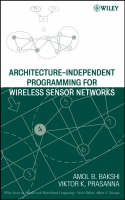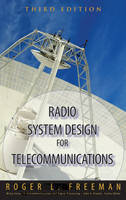Architecture-Independent Programming for Wireless Sensor Networks
 -15%
portes grátis
-15%
portes grátis
Architecture-Independent Programming for Wireless Sensor Networks
Prasanna, Viktor K.; Bakshi, Amol B.
John Wiley & Sons Inc
05/2008
208
Dura
Inglês
9780471778899
15 a 20 dias
458
Descrição não disponível.
Preface. Acknowledgments.
1. Introduction.
1.1 Sensor networks and traditional distributed systems.
1.2 Programming of distributed sensor networks.
1.2.1 Layers of programming abstraction.
1.2.1.1 Service-oriented specification.
1.2.1.2 Macroprogramming.
1.2.1.3 Node-centric programming.
1.2.2 Lessons from parallel and distributed computing.
1.3 Macroprogramming: What and Why?
1.4 Contributions and Outline.
2. The Abstract Task Graph.
2.1 Target applications and architectures.
2.2 Key Concepts.
2.2.1 Data Driven Computing.
2.2.1.1 Program flow mechanisms.
2.2.1.2 Why data driven?
2.2.2 Mixed Imperative-Declarative Specification.
2.3 Syntax.
2.3.1 The Structure of an ATaG Program.
2.3.2 More on Task Annotations.
2.3.3 Illustrative examples.
2.4 Semantics.
2.4.1 Terminology.
2.4.2 Firing rules.
2.4.3 Task graph execution.
2.4.4 get() and put().
2.5 Programming idioms.
2.5.1 Object tracking.
2.5.2 Interaction within local neighborhoods.
2.5.3 In-network aggregation.
2.5.4 Hierarchical data fusion.
2.5.5 Event-triggered behavior instantiation.
2.6 Future work.
2.6.1 State-based dynamic behaviors.
2.6.2 Resource management in the runtime system.
2.6.3 Utility based negotiation for task scheduling and resource allocation.
2.6.4 Analyzing feasibility of compilation.
3. DART:The Data Driven ATaG Runtime.
3.1 Design objectives.
3.1.1 Support for ATaG semantics.
3.1.2 Platform independence.
3.1.3 Component-based design.
3.1.4 Ease of software synthesis.
3.2 Overview.
3.3 Components and functionalities.
3.3.1 Task, Data, and Channel Declarations.
3.3.2 UserTask.
3.3.2.1 Service.
3.3.2.2 Interactions.
3.3.2.3 Implementation.
3.3.3 DataPool.
3.3.3.1 Service.
3.3.3.2 Interactions.
3.3.3.3 Implementation.
3.3.4 AtagManager.
3.3.4.1 Service.
3.3.4.2 Interactions.
3.3.4.3 Implementation.
3.3.5 NetworkStack.
3.3.5.1 Service.
3.3.5.2 Interactions.
3.3.5.3 Implementation.
3.3.6 NetworkArchitecture.
3.3.6.1 Service.
3.3.6.2 Interactions.
3.3.6.3 Implementation.
3.3.7 Dispatcher.
3.3.7.1 Service.
3.3.7.2 Interactions.
3.3.7.3 Implementation.
3.4 Control flow.
3.4.1 Startup.
3.4.2 get() and put().
3.4.3 Illustrative example.
3.5 Future work.
3.5.1 Lazy compilation of channel annotations.
3.5.2 Automatic priority assignment for task scheduling.
4. Programming and Software Synthesis.
4.1 Terminology.
4.2 Meta-modeling for the ATaG domain.
4.2.1 Objectives.
4.2.2 Application model.
4.2.3 Network model.
4.3 The programming interface.
4.4 Compilation and software synthesis.
4.4.1 Translating task annotations.
4.4.2 Automatic software synthesis.
4.4.3 The ATaG simulator.
4.4.4 Initialization.
4.4.4.1 Situatedness.
4.4.4.2 Network interface.
4.4.4.3 Network architecture.
4.4.4.4 Sensor interface.
4.4.5 Visualizing synthesized application behavior.
5 Case Study: Application Development with ATaG.
5.1 Overview of the use case.
5.2 Designing the macroprograms.
5.2.1 Temperature gradient monitoring.
5.2.2 Object detection and tracking.
5.3 Specifying the declarative portion.
5.4 Imperative portion: Temperature gradient monitoring.
5.4.1 Abstract data items: Temperature and Fire.
5.4.2 Abstract Task: Monitor.
5.4.3 Abstract Task: Temperature Sampler.
5.4.4 Abstract Task: Alarm Actuator.
5.5 Imperative portion: Object detection and tracking.
5.5.1 Abstract data items: TargetAlert and TargetInfo.
5.5.2 Abstract Task: SampleAndThreshold.
5.5.3 Abstract Task: Leader.
5.5.4 Abstract Task: Supervisor.
5.6 Application Composition.
5.7 Software Synthesis.
6 Concluding Remarks.
6.1 A framework for domain-specific application development.
6.2 A framework for compilation and software synthesis.
References.
1. Introduction.
1.1 Sensor networks and traditional distributed systems.
1.2 Programming of distributed sensor networks.
1.2.1 Layers of programming abstraction.
1.2.1.1 Service-oriented specification.
1.2.1.2 Macroprogramming.
1.2.1.3 Node-centric programming.
1.2.2 Lessons from parallel and distributed computing.
1.3 Macroprogramming: What and Why?
1.4 Contributions and Outline.
2. The Abstract Task Graph.
2.1 Target applications and architectures.
2.2 Key Concepts.
2.2.1 Data Driven Computing.
2.2.1.1 Program flow mechanisms.
2.2.1.2 Why data driven?
2.2.2 Mixed Imperative-Declarative Specification.
2.3 Syntax.
2.3.1 The Structure of an ATaG Program.
2.3.2 More on Task Annotations.
2.3.3 Illustrative examples.
2.4 Semantics.
2.4.1 Terminology.
2.4.2 Firing rules.
2.4.3 Task graph execution.
2.4.4 get() and put().
2.5 Programming idioms.
2.5.1 Object tracking.
2.5.2 Interaction within local neighborhoods.
2.5.3 In-network aggregation.
2.5.4 Hierarchical data fusion.
2.5.5 Event-triggered behavior instantiation.
2.6 Future work.
2.6.1 State-based dynamic behaviors.
2.6.2 Resource management in the runtime system.
2.6.3 Utility based negotiation for task scheduling and resource allocation.
2.6.4 Analyzing feasibility of compilation.
3. DART:The Data Driven ATaG Runtime.
3.1 Design objectives.
3.1.1 Support for ATaG semantics.
3.1.2 Platform independence.
3.1.3 Component-based design.
3.1.4 Ease of software synthesis.
3.2 Overview.
3.3 Components and functionalities.
3.3.1 Task, Data, and Channel Declarations.
3.3.2 UserTask.
3.3.2.1 Service.
3.3.2.2 Interactions.
3.3.2.3 Implementation.
3.3.3 DataPool.
3.3.3.1 Service.
3.3.3.2 Interactions.
3.3.3.3 Implementation.
3.3.4 AtagManager.
3.3.4.1 Service.
3.3.4.2 Interactions.
3.3.4.3 Implementation.
3.3.5 NetworkStack.
3.3.5.1 Service.
3.3.5.2 Interactions.
3.3.5.3 Implementation.
3.3.6 NetworkArchitecture.
3.3.6.1 Service.
3.3.6.2 Interactions.
3.3.6.3 Implementation.
3.3.7 Dispatcher.
3.3.7.1 Service.
3.3.7.2 Interactions.
3.3.7.3 Implementation.
3.4 Control flow.
3.4.1 Startup.
3.4.2 get() and put().
3.4.3 Illustrative example.
3.5 Future work.
3.5.1 Lazy compilation of channel annotations.
3.5.2 Automatic priority assignment for task scheduling.
4. Programming and Software Synthesis.
4.1 Terminology.
4.2 Meta-modeling for the ATaG domain.
4.2.1 Objectives.
4.2.2 Application model.
4.2.3 Network model.
4.3 The programming interface.
4.4 Compilation and software synthesis.
4.4.1 Translating task annotations.
4.4.2 Automatic software synthesis.
4.4.3 The ATaG simulator.
4.4.4 Initialization.
4.4.4.1 Situatedness.
4.4.4.2 Network interface.
4.4.4.3 Network architecture.
4.4.4.4 Sensor interface.
4.4.5 Visualizing synthesized application behavior.
5 Case Study: Application Development with ATaG.
5.1 Overview of the use case.
5.2 Designing the macroprograms.
5.2.1 Temperature gradient monitoring.
5.2.2 Object detection and tracking.
5.3 Specifying the declarative portion.
5.4 Imperative portion: Temperature gradient monitoring.
5.4.1 Abstract data items: Temperature and Fire.
5.4.2 Abstract Task: Monitor.
5.4.3 Abstract Task: Temperature Sampler.
5.4.4 Abstract Task: Alarm Actuator.
5.5 Imperative portion: Object detection and tracking.
5.5.1 Abstract data items: TargetAlert and TargetInfo.
5.5.2 Abstract Task: SampleAndThreshold.
5.5.3 Abstract Task: Leader.
5.5.4 Abstract Task: Supervisor.
5.6 Application Composition.
5.7 Software Synthesis.
6 Concluding Remarks.
6.1 A framework for domain-specific application development.
6.2 A framework for compilation and software synthesis.
References.
Este título pertence ao(s) assunto(s) indicados(s). Para ver outros títulos clique no assunto desejado.
methodology; sensor; explanations; applicationindependent; clear; books; deploy; aspects; nontrivial; sensing; deployment; lowlevel; knowledge; networking; applications; task; approach; abstract; new; programming; automatic
Preface. Acknowledgments.
1. Introduction.
1.1 Sensor networks and traditional distributed systems.
1.2 Programming of distributed sensor networks.
1.2.1 Layers of programming abstraction.
1.2.1.1 Service-oriented specification.
1.2.1.2 Macroprogramming.
1.2.1.3 Node-centric programming.
1.2.2 Lessons from parallel and distributed computing.
1.3 Macroprogramming: What and Why?
1.4 Contributions and Outline.
2. The Abstract Task Graph.
2.1 Target applications and architectures.
2.2 Key Concepts.
2.2.1 Data Driven Computing.
2.2.1.1 Program flow mechanisms.
2.2.1.2 Why data driven?
2.2.2 Mixed Imperative-Declarative Specification.
2.3 Syntax.
2.3.1 The Structure of an ATaG Program.
2.3.2 More on Task Annotations.
2.3.3 Illustrative examples.
2.4 Semantics.
2.4.1 Terminology.
2.4.2 Firing rules.
2.4.3 Task graph execution.
2.4.4 get() and put().
2.5 Programming idioms.
2.5.1 Object tracking.
2.5.2 Interaction within local neighborhoods.
2.5.3 In-network aggregation.
2.5.4 Hierarchical data fusion.
2.5.5 Event-triggered behavior instantiation.
2.6 Future work.
2.6.1 State-based dynamic behaviors.
2.6.2 Resource management in the runtime system.
2.6.3 Utility based negotiation for task scheduling and resource allocation.
2.6.4 Analyzing feasibility of compilation.
3. DART:The Data Driven ATaG Runtime.
3.1 Design objectives.
3.1.1 Support for ATaG semantics.
3.1.2 Platform independence.
3.1.3 Component-based design.
3.1.4 Ease of software synthesis.
3.2 Overview.
3.3 Components and functionalities.
3.3.1 Task, Data, and Channel Declarations.
3.3.2 UserTask.
3.3.2.1 Service.
3.3.2.2 Interactions.
3.3.2.3 Implementation.
3.3.3 DataPool.
3.3.3.1 Service.
3.3.3.2 Interactions.
3.3.3.3 Implementation.
3.3.4 AtagManager.
3.3.4.1 Service.
3.3.4.2 Interactions.
3.3.4.3 Implementation.
3.3.5 NetworkStack.
3.3.5.1 Service.
3.3.5.2 Interactions.
3.3.5.3 Implementation.
3.3.6 NetworkArchitecture.
3.3.6.1 Service.
3.3.6.2 Interactions.
3.3.6.3 Implementation.
3.3.7 Dispatcher.
3.3.7.1 Service.
3.3.7.2 Interactions.
3.3.7.3 Implementation.
3.4 Control flow.
3.4.1 Startup.
3.4.2 get() and put().
3.4.3 Illustrative example.
3.5 Future work.
3.5.1 Lazy compilation of channel annotations.
3.5.2 Automatic priority assignment for task scheduling.
4. Programming and Software Synthesis.
4.1 Terminology.
4.2 Meta-modeling for the ATaG domain.
4.2.1 Objectives.
4.2.2 Application model.
4.2.3 Network model.
4.3 The programming interface.
4.4 Compilation and software synthesis.
4.4.1 Translating task annotations.
4.4.2 Automatic software synthesis.
4.4.3 The ATaG simulator.
4.4.4 Initialization.
4.4.4.1 Situatedness.
4.4.4.2 Network interface.
4.4.4.3 Network architecture.
4.4.4.4 Sensor interface.
4.4.5 Visualizing synthesized application behavior.
5 Case Study: Application Development with ATaG.
5.1 Overview of the use case.
5.2 Designing the macroprograms.
5.2.1 Temperature gradient monitoring.
5.2.2 Object detection and tracking.
5.3 Specifying the declarative portion.
5.4 Imperative portion: Temperature gradient monitoring.
5.4.1 Abstract data items: Temperature and Fire.
5.4.2 Abstract Task: Monitor.
5.4.3 Abstract Task: Temperature Sampler.
5.4.4 Abstract Task: Alarm Actuator.
5.5 Imperative portion: Object detection and tracking.
5.5.1 Abstract data items: TargetAlert and TargetInfo.
5.5.2 Abstract Task: SampleAndThreshold.
5.5.3 Abstract Task: Leader.
5.5.4 Abstract Task: Supervisor.
5.6 Application Composition.
5.7 Software Synthesis.
6 Concluding Remarks.
6.1 A framework for domain-specific application development.
6.2 A framework for compilation and software synthesis.
References.
1. Introduction.
1.1 Sensor networks and traditional distributed systems.
1.2 Programming of distributed sensor networks.
1.2.1 Layers of programming abstraction.
1.2.1.1 Service-oriented specification.
1.2.1.2 Macroprogramming.
1.2.1.3 Node-centric programming.
1.2.2 Lessons from parallel and distributed computing.
1.3 Macroprogramming: What and Why?
1.4 Contributions and Outline.
2. The Abstract Task Graph.
2.1 Target applications and architectures.
2.2 Key Concepts.
2.2.1 Data Driven Computing.
2.2.1.1 Program flow mechanisms.
2.2.1.2 Why data driven?
2.2.2 Mixed Imperative-Declarative Specification.
2.3 Syntax.
2.3.1 The Structure of an ATaG Program.
2.3.2 More on Task Annotations.
2.3.3 Illustrative examples.
2.4 Semantics.
2.4.1 Terminology.
2.4.2 Firing rules.
2.4.3 Task graph execution.
2.4.4 get() and put().
2.5 Programming idioms.
2.5.1 Object tracking.
2.5.2 Interaction within local neighborhoods.
2.5.3 In-network aggregation.
2.5.4 Hierarchical data fusion.
2.5.5 Event-triggered behavior instantiation.
2.6 Future work.
2.6.1 State-based dynamic behaviors.
2.6.2 Resource management in the runtime system.
2.6.3 Utility based negotiation for task scheduling and resource allocation.
2.6.4 Analyzing feasibility of compilation.
3. DART:The Data Driven ATaG Runtime.
3.1 Design objectives.
3.1.1 Support for ATaG semantics.
3.1.2 Platform independence.
3.1.3 Component-based design.
3.1.4 Ease of software synthesis.
3.2 Overview.
3.3 Components and functionalities.
3.3.1 Task, Data, and Channel Declarations.
3.3.2 UserTask.
3.3.2.1 Service.
3.3.2.2 Interactions.
3.3.2.3 Implementation.
3.3.3 DataPool.
3.3.3.1 Service.
3.3.3.2 Interactions.
3.3.3.3 Implementation.
3.3.4 AtagManager.
3.3.4.1 Service.
3.3.4.2 Interactions.
3.3.4.3 Implementation.
3.3.5 NetworkStack.
3.3.5.1 Service.
3.3.5.2 Interactions.
3.3.5.3 Implementation.
3.3.6 NetworkArchitecture.
3.3.6.1 Service.
3.3.6.2 Interactions.
3.3.6.3 Implementation.
3.3.7 Dispatcher.
3.3.7.1 Service.
3.3.7.2 Interactions.
3.3.7.3 Implementation.
3.4 Control flow.
3.4.1 Startup.
3.4.2 get() and put().
3.4.3 Illustrative example.
3.5 Future work.
3.5.1 Lazy compilation of channel annotations.
3.5.2 Automatic priority assignment for task scheduling.
4. Programming and Software Synthesis.
4.1 Terminology.
4.2 Meta-modeling for the ATaG domain.
4.2.1 Objectives.
4.2.2 Application model.
4.2.3 Network model.
4.3 The programming interface.
4.4 Compilation and software synthesis.
4.4.1 Translating task annotations.
4.4.2 Automatic software synthesis.
4.4.3 The ATaG simulator.
4.4.4 Initialization.
4.4.4.1 Situatedness.
4.4.4.2 Network interface.
4.4.4.3 Network architecture.
4.4.4.4 Sensor interface.
4.4.5 Visualizing synthesized application behavior.
5 Case Study: Application Development with ATaG.
5.1 Overview of the use case.
5.2 Designing the macroprograms.
5.2.1 Temperature gradient monitoring.
5.2.2 Object detection and tracking.
5.3 Specifying the declarative portion.
5.4 Imperative portion: Temperature gradient monitoring.
5.4.1 Abstract data items: Temperature and Fire.
5.4.2 Abstract Task: Monitor.
5.4.3 Abstract Task: Temperature Sampler.
5.4.4 Abstract Task: Alarm Actuator.
5.5 Imperative portion: Object detection and tracking.
5.5.1 Abstract data items: TargetAlert and TargetInfo.
5.5.2 Abstract Task: SampleAndThreshold.
5.5.3 Abstract Task: Leader.
5.5.4 Abstract Task: Supervisor.
5.6 Application Composition.
5.7 Software Synthesis.
6 Concluding Remarks.
6.1 A framework for domain-specific application development.
6.2 A framework for compilation and software synthesis.
References.
Este título pertence ao(s) assunto(s) indicados(s). Para ver outros títulos clique no assunto desejado.




